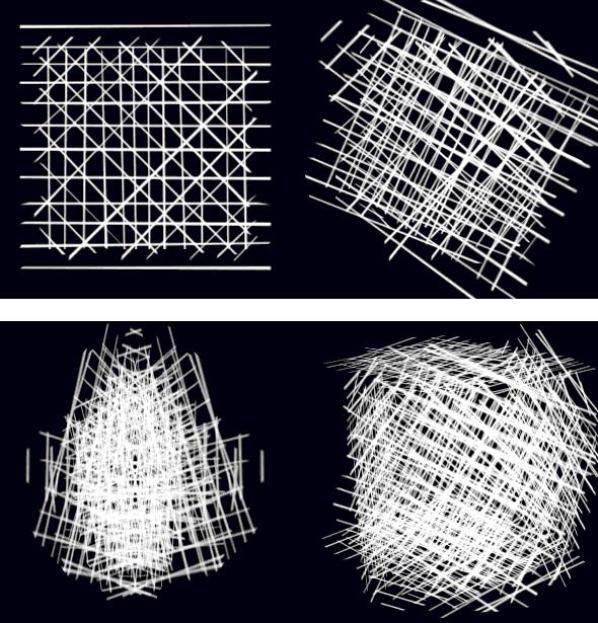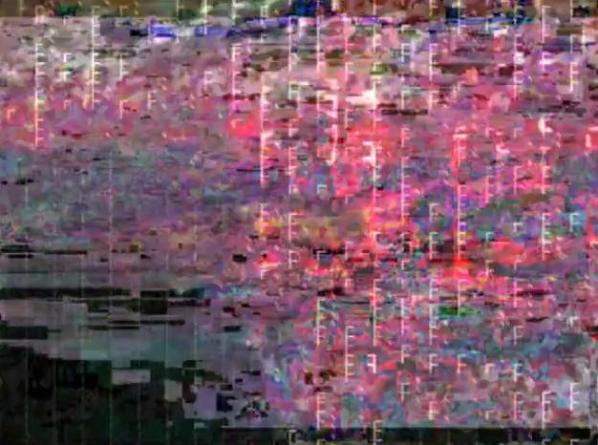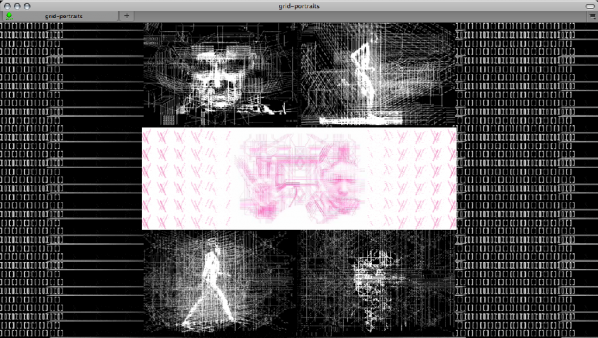



The video works of A Bill Miller seem to be at once futuristic and something recalled from our childhood (those of us who grew up with computers in some form or other) in what might be considered as a hauntological affectation that seems like a memory of the future from our childhood, with lines and simplicity of many early computer programs, forming complex ghosts of our pasts across the screen. These are a reminder that what computer graphics can do, doesn’t have to be composed of 3D, with million of vectors and a painful, failing attempt at verisimilitude. Just as theatre, with it’s artificial simplified set designs and symbolism. It can sometimes be more real, offering a greater empathy than a well designed and directed film. Often, there can be greater beauty and compulsion when engaged in simple works than those of greater complexity.
“We exist within a built environment that is constantly mediated by the grid. Grids organize space through coordinate mapping and patterns of development. Grids compress, redisplay, and reorder information. Grids are an enforcement system imposed upon both nature and culture. I respond to this ubiquity by creating gridworks. These forms examine the blurred boundary between the machine and the human – the tool of data collection and the interpretive mind.”
Like a lot of people, my first encounter with the work of A Bill Miller was on the small screen. Despite the numerous festivals and exhibitions that his works have appeared in1, this may be the only chance viewers have to enjoy them. Which is a shame because they really work well when expanded on to a larger screen. Even if you only get to view them on a larger television screen, it’s worth doing. Even some of the work that is small in scale and scope, benefits from being shown on as large a screen as possible. It takes a broader and more encompassing screen to really engage the viewer completely into the work. For some of the black and white work, the overlaying of ASCII letters (reduced to just shapes when not ‘read’ as alphanumeric characters) shows how some works can explore the technical palette of the production software as possible. Which isn’t to say that some of the works aren’t also complex and (literally) multilayered.
There is a psychic landscape explored in Miller’s works. A landscape that feels as though it sits just behind the everyday, observable world we inhabit. Not in a David Lynch, behind the picket fence, kind of way, but inside the mind’s eye, at a point where the brain hasn’t yet coalesced the datastreams of visual stimulation into a recognisable image. It’s that in-between space that seems to at the heart of some of the Gridworks: the spaces between being held in check by the grids. And clean white spaces are beautiful in themselves, but they also divide the elegance of those lines so that the work is about those spaces and the tension of being held in check: stopping them from bleeding into one another. The psychic landscape they map out is the same one that we have to face everyday as we negotiate our way through the ongoing datastream of western life. Work, rest, work, rest, shop, consume. Those days that you feel as though you’ve experienced and understood everything and life begins to blur into one continuous event: all it takes is to step back and really focus on individual moments to remind ourselves that life is actually full of thousands of unique and wonderful moments.

Works like Gridfont 7 suggest that the elegance of a few lines carefully placed can lead to great complexity through simple juxtaposition and rotation of basic forms. Just like so many other things in life, greater complexity begins to emerge from a gradual build up of even the simplest of those elements. Some of the work begins as a few short, hand-drawn lines before they re-adjust themselves and become a hive of geometric shapes: a honeycomb forming from the arrangement and connection of lines. Some works have the colour-bleed of early video work where over-saturated colours refuse to hold their place in the ordered spaces and begin to wander slightly.

gridworks_textanimation2010 is made from pure ASCII text characters, and “transmits an unreadable message that is aesthetic and abstract.” It’s stark black & white play of the non-text elements of written communication gives the impression of loss and emptiness, like lines of communication broken down through digital channels. This could be extracted from a relationship being held together via email or it could be text messages sent between two unreliable narrators each hoping to convince the other of some shared moment. A line of Xs brings to mind censorship but the blank underlines suggest space for the other party to fill in the blanks that we don’t always admit to when trying to maintain the peace in a relationship. Things are constantly being said, but nobody is ever saying anything to each other. Those are the worst accusations of Internet communications but they’re just as guilty of being performed in every other channel. They just become more visual on the Internet and even more so in works like this.
In case these descriptions suggests that the works are dry and overloaded with metaphor and meaning, they can be enjoyed on their purely aesthetic merits. Gridworks2000-anim09 is a work that can only be described as beautiful in its elegance and deceptive simplicity.
Although these works are positioned within media art, they (like many moving image art work) could be considered as cinema (and let’s face it, cinema could do with a fresh burst from a ruptured blood vessel right now). These are part of a cinema of special effects where the use of computer graphics enhances the moving image and steps away from verisimilitude. As mentioned previously, this lack of verisimilitude is part of the reality of these works. An added element of what makes them hauntological ghosts within the screen.

It’s imprinted into the very nature of cinema that it is a ghostly illusion or special effect, either computer generated or produced in the camera that belongs to every moment of cinema’s history. In fact it is even an illusion to believe that we are viewing an actual moving image when we watch a film or video. Either way, cinema is created on-the-fly by our own eye. The trick of creating moving images is to know how the brain responds to them and leverage that response to your own desires. The cross slicing of lines in Miller’s Gridworks feels so much like early computer graphics that at times it’s hard to step beyond thinking about technology’s desire for the new and the increasing momentum of the special effect algorithm and find the beauty in their simplicity. It’s in there and doesn’t take much effort to uncover. Like a good oyster in a restaurant, the reward can be unusual and pleasurable, but you have to get in and expend some energy to extract it.
FILE RIO 2012, Electronic Language International Festival, Art Galery of Oi Futuro, Rio de Janeiro, BR, Mar 12-Apr 8th
Scan2Go, New Media Caucus year long online exhibition, Released at CAA 2012
<terminal> monitors, Austin Peay State University, Clarksville, TN, 2/20-3/2
A/Vworkssssss, One Night Event/Performance, Borg Ward Collective, MIlwaukee, WI Jan 3
Streaming Festival 6th Edition, Het Nutshuis, The Hague, Netherlands, Dec. 1-18 2011
FestivalMulti2011_Especial – Curator David Quiles Guillo, Video Art Program, Rio de Janiero, BR, Nov-Dec 2011
Sheroes, One-Night Interactive Installations (Monthly), Toronto, CA, Nov. 18 and Dec. 23
GLI.TC/H Chicago – Live Video Performance, Chicago, IL Nov. 3-7
GLI.TC/H Program at FLIP Animation Festival, Birmingham, UK, Oct. 29
Punto Y Raya Festival, Museo Reina Sofia Madrid, November 3-6, 2011
BYOB Sao Paulo, Rojo Nova Sao Paulo, Oct. 29
Video On Paper Zine http://videoonpaper.tumblr.com/
3ra Convocatoria Belica, Valencia, Venezuala, September 2011 http://mvs.260mb.com/index2.html
I AM NOT A POET Festival, Edinburgh Aug.8-21 http://tkunst.wordpress.com/